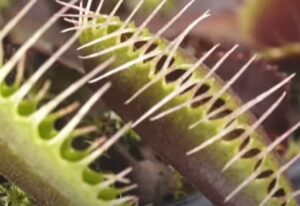As an Amazon Associate, this site earns commissions from qualifying purchases. For more details, click here.
Pitchers on nepenthes and sarracenia have to be open, otherwise they will not be able to get any nutrients. Sometimes however you will see the lids are closed. This is not normal but fortunately, you can fix this using any of the following tips.
A closed pitcher plant means humidity is too low, there is lack of water, the soil is not moist enough or a combination of those factors. The lids will open when the humidity has increased and the environment is more conducive to growth and feeding.
Why Pitcher Plants Close
The lid on pitcher plants prevent debris and too much water from getting in the traps. Too much water will dilute the viscous liquids which are used to digest fallen prey, so the lid does not cover the pitcher.
Ready to Grow Carnivorous Plants with Confidence?
Stop guessing and start thriving. Whether you’re raising flytraps, sundews, Nepenthes, or butterworts, this visual-first guide gives you everything you need — from lighting and watering to feeding and seasonal care.
- Beginner-proof diagrams
- Step-by-step routines
- Instant PDF download

If you notice that the lid has sealed the trap, it means there is something wrong with the plant. There are many possible reasons but these are the most likely.
Incorrect soil. Carnivorous plants should only be planted in nutrition deprived soil. These plants evolved and adapted to their environment so they obtain nutrients from insects, not the ground. Fertilizer is great for other plants, but for carnivorous plants it is the opposite.
Dry soil. Pitcher plants can only survive in moist soil. If you leave the soil to dry this could destroy the plant in a matter of days. You should never over water a pitcher plant, but do not let the moisture disappear completely.
Not enough humidity. Sarracenia, nepenthes and other pitcher plants will not last in low humidity. Yes these plants prefer lots of sunlight, but they also benefit from high humidity. When the air dries up, these plant have a harder time performing regular functions.
Temperature extremes. Pitcher plants can only feed in ideal temperatures. Most nepenthes species prefer 65-85 F (about 18-30 C), but some variants can handle 50 F (10 C) while there are others which hold up to 95 F (35 C), though rare.
Disease. If the pitcher is closed and leaves are turning black , it could be a sign of disease. Plants can be afflicted by fungal or bacterial diseases and other ailments. A large infestation of insects can weaken the plant, affecting its ability to keep the pitcher open.
How to Get Pitcher Plants to Open
Unless your pitcher plant can handle extreme temperatures, its functions will be affected. Some pitcher plants go dormant and others do not, so you have to factor that in as well. All of these will have an effect on its pitchers and can cause them to shut. This will cause problems and have to be fixed right away.
In the following sections we show you the various ways to encourage the plant to open its pitchers. A healthy location, water, and the presence of pollinators like snails are always good. But for a closed pitcher there are additional things that need to be done.
Increase Humidity
Humidity can be an issue during hot days. However there are a couple of ways to resolve this issue depending on your situation.
Water more often. Mist or water the plant from the top. Nepenthes does not like sitting in water, but some sarracenia species do. If you have sarracenia, you may use the tray method and add 1-1.5 inches of water. For nepenthes, water frequently.
install a humidifier. This is good option for indoor pitcher plants. With this device you can fine tune the humidity to precise levels. The most important thing is to get a quality product to ensure the best results. There are a lot of options but one particularly like is the MistAire Humidifier as pitcher plants respond to it well.
Fix the Temperature
This can be a real problem especially if your pitcher plants are outdoors. If it is indoors, you can use a humidifier, but even then it is limited to the humidity and not the temperature.
The simplest solution is to buy only pitcher plants that naturally grow in your location. This way, the plant does not have to do a lot of adjustment. The less adjustments required, the less stressed out the plant will be.
Can you grow pitcher plants that are not local to your area? Yes, but you have to prepare and make a lot of adjustments. If the plant prefers tropical weather and it gets cold in the winter, make the proper arrangements to keep the plant comfortable. But with planning it can be done.
Use the Right Soil Mix
The rule is simple: never use nutrient rich potting media. Any type of rich potting, fertilized soil should be avoided. The most widely used soil mix for pitcher plants is 1:1 peat moss and perlite. You can try other media as long as they do not contain nutrients.
To keep things simple we recommend a ready to use soil potting mix so you don’t have to do any mixing. Our choice is Soil Sunrise Carnivorous Mix because it is compatible with nepenthes, sarracenia and other carnivorous pitcher plants.
It might be tempting to use nutrient rich material since the pitchers are closed. Yes, closed pitchers means the plant is not getting any nutrients. But you cannot replace the elements from insects with those from the soil. Pitcher plants are not capable of processing nutrients from the ground. They can only do it with nutrients obtained from their traps.
Keep Soil Moist
Water the plant to keep the soil from drying out. The tricky part is trying to get the balance right. The soil cannot be too wet but it should not be too dry either.
Touch the soil. If it feels damp but not watery, it is the right consistency. If water seeps when you press the soil, it is drenched. It is also easy to tell if the soil has dried, so water as often as necessary.
Never use tap water on pitcher plants because they contain elements detrimental to plants. Distilled water is preferable. During the rainy season you can collect rainwater and use that instead.
How to Deal with Plant Disease
If pitchers are shut due to disease, you have to find out the cause first. Here are some suggestions.
Insect infestation. Examine the plant closely and look for signs of pests. These include the bugs or their eggs, half eaten leaves, liquids or debris around the plant. Do this whether the plant is outdoors or indoors.
Immersing the plant in water might kill off the pests. If not, use a pesticide to get rid of them. Use only ones that are certified safe for pitcher plants and follow the instructions.
Fungal or bacterial infection. These ailments spread rapidly so you have to act fast. Cut off the infected pitchers and leaves. Next, you have to repot the plant. Carefully unpack the soil and pull the plant out.
If the roots are completely mush, there is no way to save it. But if there are still healthy parts, keep them. Cut off all the rest. Get a new pot and prepare new soil (nutrition free). Place the plant there and provide as much humidity as possible (up to 70-80%). Combined with sunlight, it could get the pitchers to open up again.
What Happens if Pitcher Plants Do Not Open?
Pitcher plants will weaken if their traps remain closed. Creating traps takes a lot of resources. Aside from the leaves, a plant has to make nectar to entice prey. Fluids must also be produced in the pitcher to trap and digest insects.
Nutrients play a vital role in pitcher plant growth and development. Strictly speaking, glucose is plant food, produced via photosynthesis. But nutrients augment glucose and allow plants to do more without losing too much fuel.
In spite of popular belief, pitcher plants are not hard to keep alive. You simply need to take the right approach and the plant will thrive. However, problems will occur if you do not take action, so in this case use these suggestions to get your pitcher plant to open.
Conclusion
The environment plays a significant role in how well pitcher plants grow. If you see that its lids are closed, you need to take action as soon as possible. With the information given here, your pitcher plant should recover and start absorbing nutrients again.

My fascination with carnivorous plants began many, many years ago with Venus Fly Traps. Now I am more than happy to impart what I know with other enthusiasts and those who are curious about meat eating plants.



